《英语修辞学EnglishRhetoric》第一章IntroductiontoEnglishRh
- 格式:pdf
- 大小:9.78 MB
- 文档页数:52
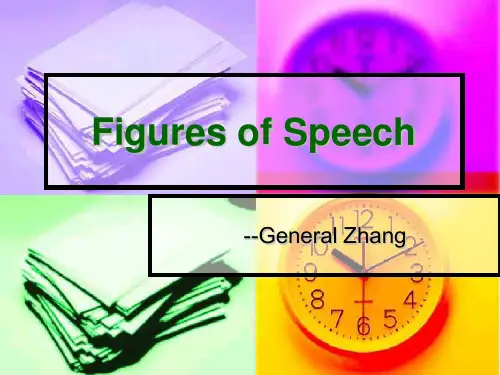
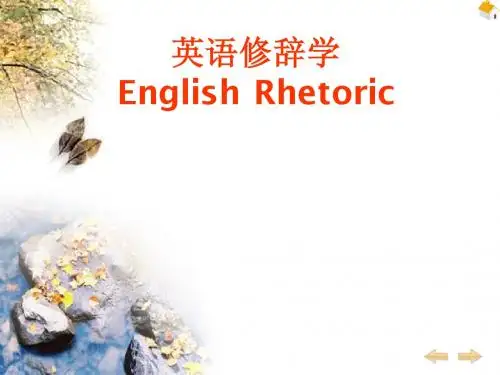
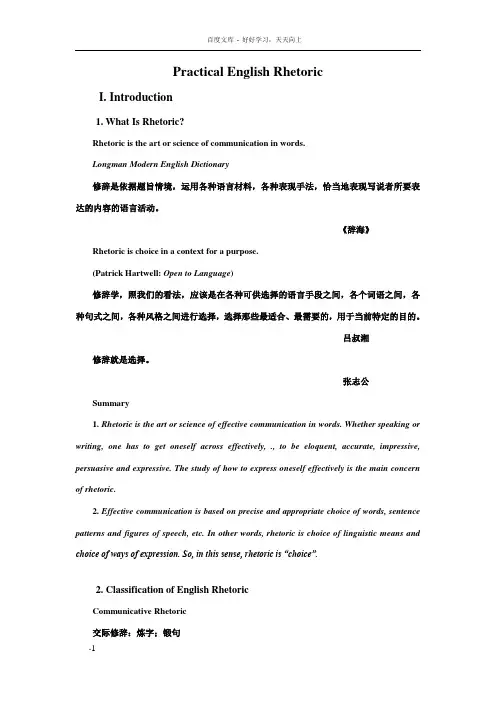
Practical English RhetoricI. Introduction1. What Is Rhetoric?Rhetoric is the art or science of communication in words.Longman Modern English Dictionary修辞是依据题旨情境,运用各种语言材料,各种表现手法,恰当地表现写说者所要表达的内容的语言活动。
《辞海》Rhetoric is choice in a context for a purpose.(Patrick Hartwell: Open to Language)修辞学,照我们的看法,应该是在各种可供选择的语言手段之间,各个词语之间,各种句式之间,各种风格之间进行选择,选择那些最适合、最需要的,用于当前特定的目的。
吕叔湘修辞就是选择。
张志公Summary1. Rhetoric is the art or science of effective communication in words. Whether speaking or writing, one has to get oneself across effectively, ., to be eloquent, accurate, impressive, persuasive and expressive. The study of how to express oneself effectively is the main concern of rhetoric.2. Effective communication is based on precise and appropriate choice of words, sentence patterns and figures of speech, etc. In other words, rhetoric is choice of linguistic means and choice of ways of expression. So, in this sense, rhetoric is “choice”.2. Classification of English RhetoricCommunicative Rhetoric交际修辞:炼字;锻句Aesthetic Rhetoric美学修辞:各种修辞格Communicative rhetoric lays particular stress on lexical accuracy, structural meticulousness and contextual appropriateness so as to bring its linguistic communicative role into full play.Example (1)She sat at the window watching the evening invade the avenue. Her head was leaned against the window curtains and in her nostrils was the odor of dusty cretonnes.She was tired.(James Joyce: “Eveline”) Example (2)Dick Boulton looked at the doctor. Dick was a big man. He knew how big a man he was. He liked to get into fights. He was happy. Eddie and Billy Tabeshaw leaned on their cant hooks and looked at the doctor. The doctor chewed the beard on his lower lip and looked at Dick Boulton. Then he turned away and walked up the hill to the cottage. They could see from his back how angry he was. They all watched him walk up the hill and go inside the cottage.(E. Hemingway: “The Doctor and the Doctor’s Wife”)Aesthetic rhetoric gives special emphasis to the employment of figures of speech in virtue of imagination and association so that the language used will be more colorful and expressive, the images created on the reader’s mind will be more vivid and impressive. As a result, the writing will be more persuasive and of more artistic appeal.Example (3)We are resolved to destroy Hitler and every vestige of the Nazi regime. From this nothing will turn us—nothing. We will never parley, we will never negotiate with Hitler or any of his gang. We shall fight him by land, we shall fight him by sea, we shall fight him in the air until, with God’s…(Churchill: “Speech on Hitler’s Invasion of theExample (4)She looked bloated, like a body long submerged in motionless water, and of that pallid hue. Her eyes, lost in the fatty ridges of her face, looked liked two small pieces of coal pressed into a lump of dough as they moved from one face to another while the visitors stated their errand.(William Faulkner: “A Rose for Emily”)3. Why Is Rhetoric to Be Learned?Rhetoric is ubiquitous. It permeates our life. Without rhetoric there would be no media, no language, no life.实用英语修辞是一门重要的课程,它对于提高英语学习者对语言的悟性,增强他们语言表达的得体性至关重要。
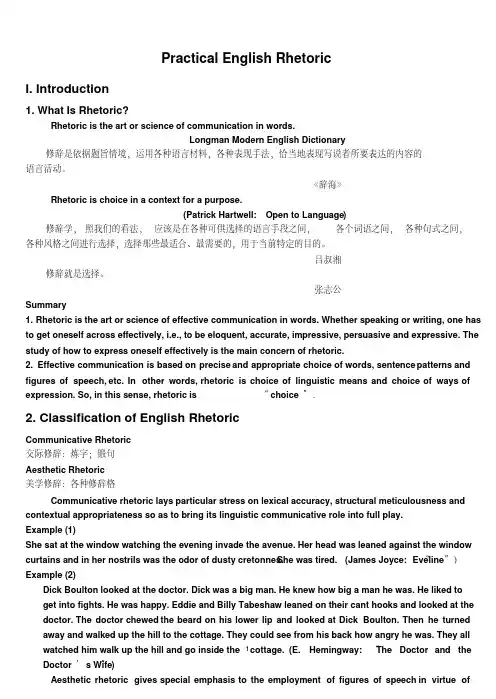
1 Practical English RhetoricI. Introduction1. What Is Rhetoric?Rhetoric is the art or science of communication in words.Longman Modern English Dictionary修辞是依据题旨情境,运用各种语言材料,各种表现手法,恰当地表现写说者所要表达的内容的语言活动。
《辞海》Rhetoric is choice in a context for a purpose.(Patrick Hartwell: Open to Language)修辞学,照我们的看法,应该是在各种可供选择的语言手段之间,各个词语之间,各种句式之间,各种风格之间进行选择,选择那些最适合、最需要的,用于当前特定的目的。
吕叔湘修辞就是选择。
张志公Summary1. Rhetoric is the art or science of effective communication in words. Whether speaking or writing, one has to get oneself across effectively, i.e., to be eloquent, accurate, impressive, persuasive and expressive. The study of how to express oneself effectively is the main concern of rhetoric.2.Effective communication is based on precise and appropriate choice of words, sentence patterns and figures of speech, etc. In other words, rhetoric is choice of linguistic means and choice of ways of expression. So, in this sense, rhetoric is “choice ”.2. Classification of English RhetoricCommunicative Rhetoric交际修辞:炼字;锻句Aesthetic Rhetoric美学修辞:各种修辞格Communicative rhetoric lays particular stress on lexical accuracy, structural meticulousness and contextual appropriateness so as to bring its linguistic communicative role into full play.Example (1)She sat at the window watching the evening invade the avenue. Her head was leaned against the window curtains and in her nostrils was the odor of dusty cretonnes.She was tired. (James Joyce: “Eveline ”)Example (2)Dick Boulton looked at the doctor. Dick was a big man. He knew how big a man he was. He liked to get into fights. He was happy. Eddie and Billy Tabeshaw leaned on their cant hooks and looked at the doctor. The doctor chewed the beard on his lower lip and looked at Dick Boulton. Then he turned away and walked up the hill to the cottage. They could see from his back how angry he was. They all watched him walk up the hill and go inside the cottage.(E. Hemingway: “The Doctor and the Doctor ’s Wife ”)Aesthetic rhetoric gives special emphasis to the employment of figures of speech in virtue of2imagination and association so that the language used will be more colorful and expressive, the images created on the reader’s mind will be more vivid and impressive. As a result, the writing will be more persuasive and of more artistic appeal. Example (3)We are resolved to destroy Hitler and every vestige of the Nazi regime. From this nothing will turn us —nothing. We will never parley, we will never negotiate with Hitler or any of his gang. We shall fight him by land, we shall fight him by sea, we shall fight him in the air until, with God’s …(Churchill: “Speech on Hitler ’s Invasion of the U.S.S.R.”)Example (4)She looked bloated, like a body long submerged in motionless water, and of that pallid hue.Her eyes, lost in the fatty ridges of her face, looked liked two small pieces of coal pressed into a lump of dough as they moved from one face to another while the visitors stated their errand.(William Faulkner: “A Rose for Emily ”)3. Why Is Rhetoric to Be Learned?Rhetoric is ubiquitous. It permeates our life. Without rhetoric there would be no media, no language, no life.实用英语修辞是一门重要的课程,它对于提高英语学习者对语言的悟性,增强他们语言表达的得体性至关重要。
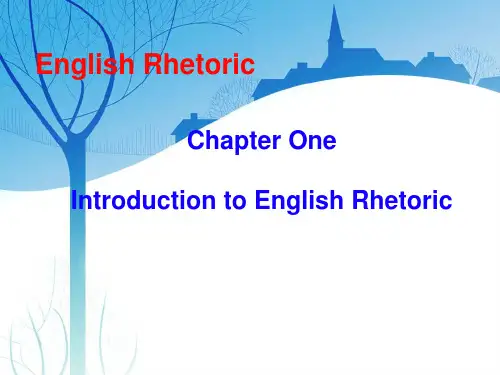
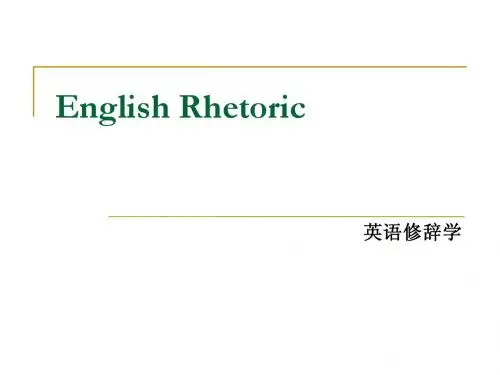
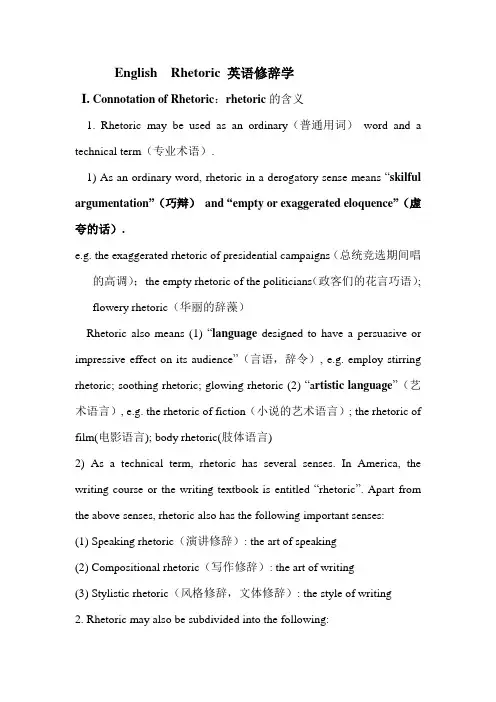
English Rhetoric 英语修辞学I. Connotation of Rhetoric:rhetoric的含义1. Rhetoric may be used as an ordinary(普通用词)word and a technical term(专业术语).1) As an ordinary word, rhetoric in a derogatory sense means “skilful argumentation”(巧辩)and “empty or exaggerated eloquence”(虚夸的话).e.g. the exaggerated rhetoric of presidential campaigns(总统竞选期间唱的高调);the empty rhetoric of the politicians(政客们的花言巧语);flowery rhetoric(华丽的辞藻)Rhetoric also means (1) “language designed to have a persuasive or impressive effect on its audience”(言语,辞令), e.g. employ stirring rhetoric; soothing rhetoric; glowing rhetoric (2) “a rtistic language”(艺术语言), e.g. the rhetoric of fiction(小说的艺术语言); the rhetoric of film(电影语言); body rhetoric(肢体语言)2) As a technical term, rhetoric has several senses. In America, the writing course or the writing textbook is entitled “rhetoric”. Apart from the above senses, rhetoric also has the following important senses:(1) Speaking rhetoric(演讲修辞): the art of speaking(2) Compositional rhetoric(写作修辞): the art of writing(3) Stylistic rhetoric(风格修辞,文体修辞): the style of writing2. Rhetoric may also be subdivided into the following:1) Lexical rhetoric(词汇修辞):the rhetorical law of choosing words and phrases2) Sentence rhetoric(句子修辞):the rhetorical law selecting sentence patterns3) Paragraph rhetoric(段落修辞):the rhetorical law of organizing paragraphs4) textual rhetoric(语篇修辞):the rhetorical law of organizing textsII. Definition of Rhetoric修辞学的定义What is rhetoric ?1.Origin of modern rhetoric: 现代修辞学的起源Rhetoric originated in “speaking”(说话). Aristotle(亚里士多得), in the 4th century BC, first defined rhetoric as the art of persuasion, equivalent to argumentation as people understand today. John Locke(约翰.洛克), English philosopher of the late 17th century, described rhetoric as “the science of oratory(演说术)” or “the art of speaking with propriety, elegance and force(修辞学是说话得体、优美和有力的艺术)”. All this explains why the word “rhetoric” means “speaking”in such European languages as Greek, Latin, French, Spanish and Italian. In the book Modern Rhetoric by American linguists Brooks(布鲁克斯)and Warren(沃伦)rhetoric is defined as “the art of using language effectively(修辞学是有效地使用语言的艺术)”.In the New Oxford Dictionary of English rhetoric is described as “the art of effective or persuasive speaking or writing, especially the exploitation of figures of speech or other compositional techniques(修辞学是有效或有说服力的演说或写作的艺术,特别是运用英语修辞格或其它写作的艺术)”.2.Rhetoric and Figures of Speech:Figures of speech are quite different from rhetoric, but they are important components in English rhetoric. In the New Oxford Dictionary of English, “figure of speech” is defined as “ a word or phrase used in a non-literal sense too add rhetorical force or interest to a spoken or written passage”(修辞格是用一个非字面意义的单词或短语使一段口头或笔头的文字增加修辞效果或兴趣). They refer to rhetorical devices(修辞手段), each of which has a fixed pattern, e.g. Simile is introduced by comparative words as, like, as if, as though, etc.; Like Simile, Metaphor refers to the comparison of two essentially unlike things which have one point of resemblance;Irony refers to the intended implication of which is the opposite of the literal sense of words; Oxymoron refers to the conjunction of two words or phrases which are incongruous or contradictory in sense so as to describe a person or thing; Pun; a play on words, sometimes on different senses of the same word and sometimes onthe similar sense or sound of different words; etc. These figures are employed in the following.He is as stupid as a goose. (=He is very stupid.)He has a heart of stone./ He has a heart like flint.(=He is unfeeling and stubborn.)He slept like a log / top. (=He slept very soundly.)They are birds of a feather. (=They are people of the same sort.) (Simile and metaphor are used of the comparison of two essentially unlike things which have one point of resemblance.) This hard-working boy seldom reads more than an hour per week. (If a boy seldom reads more than an hour per week, he must be very lazy, not hard-working.)(Irony refers to the intended implication being the opposite of the literal sense of words)He seems to be a clever fool. (=He seems to be a fool, but in fact he is very clever.)(Oxymoron refers to the conjunction of two words or phrases which are incongruous or contradictory in sense)Ask for me tomorrow and you shall find me a grave man.(grave: adj. serious; n. tomb The speaker stresses the latter.) (Pun refers to a play on words,sometimes on different senses of the same word and sometimes on the similar sense or sound ofdifferent words)3.The difference between rhetoric and grammar, phonetics,lexicolog y1)The difference between rhetoric and grammarRhetoric is different from grammar, but it is closely related to grammar and also based on grammar. To be grammatically correct is foundation to writing, but it is not enough. Basic rhetorical requirements must also be met. Francis Christensenn, an American French rhetorician, once said:Grammar maps out the possible(计划可能发生的事情);rhetoric narrows the possible down to the desirable and effective (使可能发生的事情变成很理想的事情或有效地事情).In the preface to the book A handbook of English Rhetoric Warren quoted a passage by a scholar:Grammar is the law of language, considered as language;rhetoric is the art of language, considered as thought.Grammar tells what is correct; rhetoric tells what is effective and pleasing.2)Rhetoric and phonetics, lexicologyRhetoric is quite different from phonetics and lexicology. Phonetics is about the study of speech sounds and their pronunciation;lexicology is about the study of the vocabulary of a language;grammar concerns the study or science of rules for forming words and combining them into sentences; whereas rhetoric is the art of speaking or writing so as to persuade people effectively.I II. The Object of the Study of Rhetoric(修辞学研究的内容)Rhetoric aims at studying all forms of culture, which may be forms of mass media or any cultural phenomenon, concrete or abstract. Modern rhetoric seems to include all forms of discourse ---- written or colloquial, even all forms of communication in symbols.(修辞学研究的对象是一切文化形式,它们可以是任何这样或那样、具体或抽象的文化现象。
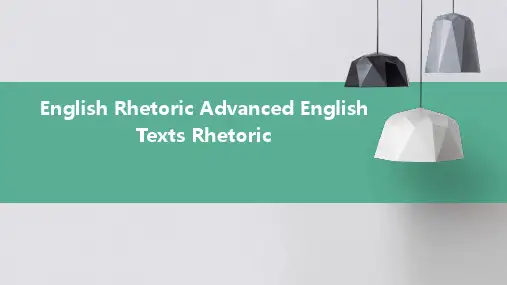
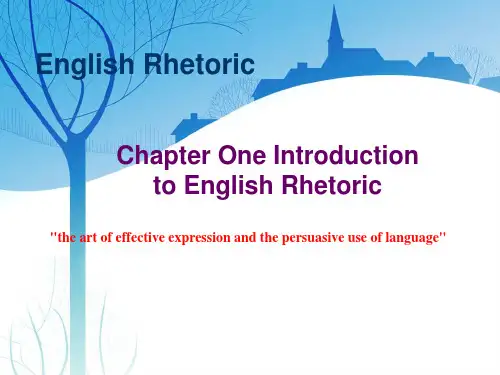
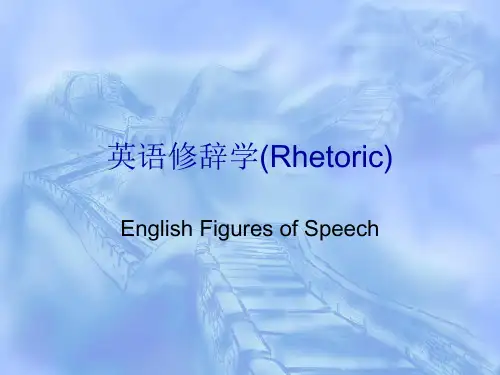
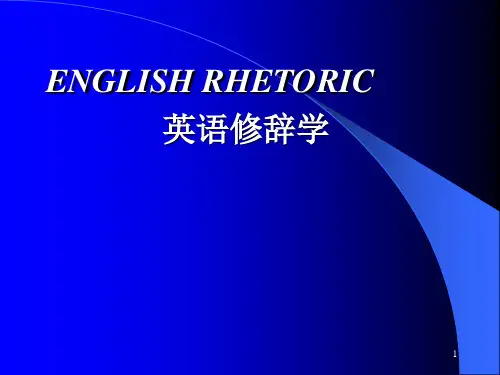
英语修辞学Sshandouts1English Rhetoric Chapter 1The definition of Rhetoric:n.1. a. The art or study of using language effectively and persuasively.b. A treatise or book discussing this art.2. Skill in using language effectively and persuasively.3. a. A style of speaking or writing, especially the language ofa particularsubject: fiery political rhetoric.b. Language that is elaborate, pretentious, insincere, or intellectually vacuous:His offers of compromise were mere rhetoric.4. Verbal communication; discourse.-- The free online dictionarySome more Definitions of RhetoricPlato: Rhetoric is "the art of winning the soul by discourse."Aristotle:Rhetoric is "the faculty of discovering in any particular case all of the available means of persuasion.Cicero: "Rhetoric is one great art comprised of five lesser arts: inventio, dispositio, elocutio, memoria, and pronunciatio." Rhetoric is "speech designed to persuade."Quintillian: "Rhetoric is the art of speaking well."Francis Bacon: Rhetoric is the application of reason to imagination "for the better moving of the will."George Campbell: [Rhetoric] is that art or talent by which discourse is adapted to its end. The four ends of discourse are to enlighten the understanding, please the imagination, move thepassion, and influence the will.A. Richards: Rhetoric is the study of misunderstandings and their remedies. Kenneth Burke: "Rhetoric is rooted in an essential function of language itself, a function that is wholly realistic and continually born anew: the use of language as a symbolic means of inducing cooperation in beings that by nature respond to symbols.""Wherever there is persuasion, there is rhetoric, and wherever there is rhetoric, there is meaning."Richard Weaver: Rhetoric is that "which creates an informed appetition for the good."Erika Lindemann: "Rhetoric is a form of reasoning about probabilities, based on Assumptions people share as members of a community."Andrea Lunsford: "Rhetoric is the art, practice, and study of human communication."Francis Christensen: "Grammar maps out the possible; rhetoric narrows the possible down to the desirable or effective." "The key question for rhetoric is how to know what is desirable."Sonja and Karen Foss: "Rhetoric is an action human beings perform when they use symbols for the purpose of communicating with one another . . , [and it] is a perspective humans take that involves focusing on symbolic processes."Reading 1The following is an excerpt from Erich Segal’s novel Man, Woman and Child, which tells about how Shiela (the wife) was shocked when Robert (her husband) confessed that he once had an affair with another woman. Can you find any figures of speech in this piece? Does it reach the goal of communication? If so, what makes it effective and expressive?(H – husband; W – wife. And for the convenience of analysisthe conversation is numbered.)1)H: Honey, I gotta talk to you.2)W: Sure. Is something wrong?3)H: Well, sort of. Yes.4)W: Bob, something in your voice scares me. Have I doneanything?5)H: No. It’s me. I’ve done it. Shiela, remember when you werepregnant with Paula?6)W: Yes?7)H: I had to fly to Europe – Montpellier – to give thatpaper…8)W: And?9)H: I had an affair.10)W: No. This is some terrible joke. Isn’t it?11)H: No. It’s true. I –I’m sorry.12)W: Who?13)H: Nobody. Nobody special.14)W: Who, Robert?15)H: Her – her name was Nicole Guirin. She was a doctor.16)W: And how long did it last?17)H: Two, three days.18)W: Two days or three days? I want to know.19)H: Three days. Does all this matter?20)W: Everything matters. I thought our marriage was based ontotal honesty. Why didn’t you ever tell me?21)H: I was waiting for the right moment.22)W: And ten years later was the right moment? No doubt youthought it would be easier. On whom?23)H: I didn’t want to hurt you, Shiela. If it’s anyconsol ation, that’s the only time.24)W: No, it isn’t any consolation. Once is more than never.25)H: Shiela, that was so long ago. I had to tell you now because–I mean… She’s dead.26)W: For God’s sake. Bob, why are you telling me all this?27)H: Shiela, I am telling you because she had a child.28)W: And we have two – so what?29)H: He’s mine. The boy is mine.30)W: Oh, no, it can’t be true.31)H: Yes, it is true. I didn’t know about him. Shiela. Pleasebelieve me.32)W: Why? Why should I believe anything you tell me now?33)H: Shiela, listen –34)W: No. I’ve heard enough. Bob, why’d you have to tell me?Why?35)H: Because I don’t know what to do. And because I somehowthought you’d help.36)W: You can’t know how it hurts. I trusted you. I trusted.–37)H: Please, honey. I’ll do anything to make it right.38)W: You can’t.39)H: You don’t mean that you want to split…?40)W: Robert, I don’t have any strength right now. For anything.You could do me a big favor.41)H: Anything?W: Sleep in your study, please.Reading 2:Rhetorical principles for arranging one’s data in writing:The first principle is “obvious before remarkable, i.e., to put one’s basic points before the more innovative or novel material. This is like “bridge building”: creating a stable progress ion from what is more solidly established to what is new.The second is “presentation before refutation.”In using this scheme, the writer should present or review the argument he or she intends to discount before proceeding to the actual refutation.A prin ciple somewhat related to the second is “explanation before complication”–supplying the reader with necessary basic information on a topic or issue before offering more complicated discussion of the topic or issue.“Solvable before unsolvable”is the fourt h principle under our discussion. When one has to describe in a paper a series of problems, some of which have apparent solutions while others do not, they should not be listed in random order; instead, they should be presented according to their degree of apparent solvability. Such an arrangement would best fit the notion of bridge building, allowing the writer to establish more solvable problems as relatively more stable bases from which to proceed to the discussion of less solvable problems.The fifth principle, similar to the second, is called “appreciation before criticism.” This principle, not to be confused with the standard rhetorical advice to establish common ground with one’s opposition, applies to the arrangement of placing positive aspects of his or her critiquebefore negative aspects.The sixth arrangement scheme is “literal before symbolic,” which a writer can employ when writing analytic or interpretive essays. According to this strategy, when a paper includes both literal and symbolic interpretations, as of a line or image from a poem, for example, literal observations generally proceeds the symbolic counterparts of those observations, for the symbolic interpretation in some respect arises from literal one.Principle 7 is “rule before exceptions,” which is to advise a writer to place ideas or examples that constitute or support what is generally or typically the case before looking at those that deviate. Stating exceptions before rules is obviously possible, but doing so requires a better skill of arrangement and presentation so as to put the cart beforethe horse. This point applies to the previous principles as well.(Adapted from “Identifying and Teaching Rhetorical Plans for Arrangement” by Joanne M. Podis and Leonard A. Podis) Exercise OneI. Fill in each blank with a suitable word.1.Rhetoric involves practicing the most ____ means or strategies forinforming ____ persuading an audience. All writing, ____ technical or business writing, is “____.”Deciding what to write, ____ to write it, ho w best to ____ your reader’s attention, and how to ____ or persuade your reader requires creativity ____ imagination. Every field of study requires the skills ____ writing courses teach: exploring new ideas, ____ concepts and processes, communication with others, ____ finding fresh or creative solutions to ____.2.Grammar is the law of ____ language, considered aslanguage;rhetoric ____ the art of language, considered ____ thought.Grammar tells what is ____; rhetoric tells what is effective ____ pleasing.II. Compare the following pairs of sentences, and determine which sentence is more effective.1.A) They wander into the church and aimlessly look around.B) They wander into the church and look around aimlessly.2.A) They, at last, know what they are seeing.B) They know what they are seeing at last.3.A) The curtain comes down as soon as the last boat has gone.B) As soon as the last boat has gone, down comes the curtain.4.A) The boy said that he was thirsty and could drink a big bottle ofwater.B) The boy said that he was dying of thirst and could drink up thewhole sea.。
《英语修辞学》课程教学大纲一、课程基本信息1.课程编号:325025062.课程名称:英语修辞学3.英文名称:English Rhetoric4.课程简介:《英语修辞学》是为英语专业本科高年级开设的一门专业选修课,适用于英语专业教师教育方向和应用翻译方向,于第五学期开设,主要讲授英语修辞的基本原理及其应用,以及各类英语文体的语言风格特征,旨在引导学习者全面认识英语的语体特征、文体风格及其修辞要求和技巧,从本质上了解英语语体,掌握各类文体的修辞手段和语言特点,熟悉各种修辞手法,各类英语的功能,掌握语言使用中的"常规”和变异及其在各种文体中所表现出的规律,提高语言使用中的修辞与文体意识,使学习者具备一定的文学批评和对各类文体的分析和鉴赏水平。
二、课程说明1.教学目的和要求:通过本课程的学习,使学习者较系统地了解英语修辞产生的原因及其对提高语言表现力的重要作用认识,增强对英语的理解能力,提高恰当运用英语语言的交际能力。
学会从修辞的观点出发,从英语语言现象入手,对其涵进行分析,初步掌握对各类文体的语言进行研究、分析和比较的方法。
掌握各种主要的修辞手段,提高实践中运用英语的能力和理解与欣赏英语文体的能力。
2.与相关课程衔接:先修课程:《英语国家概况》、《基础英语》、《英语听说》、《英语阅读》、《英语写作》、《英语语法》、《英国文学》等专业必修课,以及《英语词汇学》、《西方文化入门》等选修课。
并修课程:《高级英语》、《英语语言学》、《英国文学》后续课程:《美国文学》、《学术论文写作》等必修课,《笔译1》、《笔译2》、《口译1》、《口译2》、《实用文体翻译》等专业方向课程,以及《跨文化交际》、《商务英语翻译》、《经贸口译》、《会展口译》、《计算机辅助翻译》等选修课程。
3.学时:本课程周学时为2,共开16周,讲授学时32,总学时32,共计2学分。
4.开课学期:本课程于第五学期开设5.教学方法:以教师为主导、学生为中心。